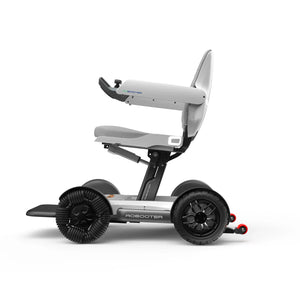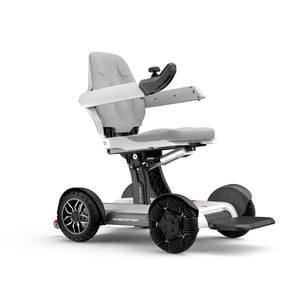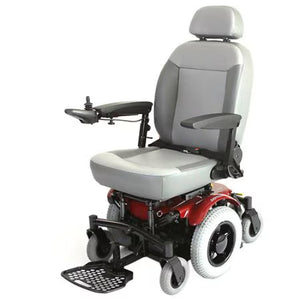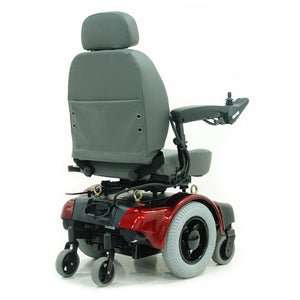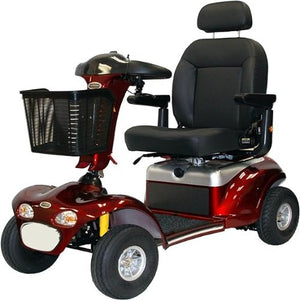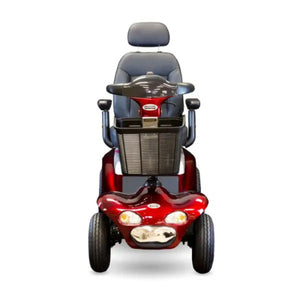Are you torn between investing in a scooter vs power wheelchair? Picking the perfect mobility aid might be tough with all the choices out there, but it's worth taking the time to find what suits you best. In this article, we'll explore the differences between scooters and power wheelchairs, guiding you towards making a well-informed decision.
Power Wheelchairs Vs. Mobility Scooters:
1- Battery Life:
You'll find rechargeable batteries in power wheelchairs, while mobility scooters offer a variety of battery choices.
Power wheelchairs can travel 8-18 miles per charge, while full-size scooters can go up to 40 miles. Both types usually take between 8 and 14 hours to charge.
2- Weight Capacity:
Power wheelchair weight capacities depend on the model. Foldable ones support lighter weights, while heavy-duty bariatric power chairs can handle between 400 and 700 lbs.
Mobility scooters, particularly bariatric models, can support even higher weights, exceeding 600 pounds.
3- Foldability:
Some power wheelchairs fold into one piece or break apart into lightweight sections for easy transport. However, foldable wheelchairs have lower weight limits and use less sturdy materials.
Foldable mobility scooters either break down without tools or fold up into one piece, making them super convenient for storage and travel.
4- Accessories Included:
Power wheelchairs give you more options for seating, padding, and controls. They come with features like adjustable footrests and captain-style seats.
Mobility scooters usually have basic vinyl seats that you can adjust and swivel for comfort.
5- Wheel Types:
Mobility scooters come with three or four wheels, so you can choose between stability and maneuverability.
Power wheelchairs have four to six wheels and various models like front, mid, and rear-wheel drive. Each type has its perks, like adapting to different terrains or offering strong outdoor performance.
6- Controller Variations:
Power wheelchairs mainly use joystick controllers for precise control, even if you have limited arm or hand strength. Mobility scooters, however, use handlebars or tillers, which need more upper-body strength and power.
Physical Ability: Differences In Driving Requirements:
Electric Scooters:
- Climbing Ability: Riders should be able to fold armrests, get on the platform, and get off. Swivel seats can help those with back problems.
- Arm Strength: Riders should possess enough upper body strength to keep their arms extended for extended durations and be comfortable steering with both hands.
- Torso Control: Sitting upright and staying stable in the seat is essential, as lighter models might not have seat belts or headrests. Four-wheel scooters provide more stability for those with balance issues.
Power Wheelchairs:
1- Small Movements:
Operated by a joystick or control pad, power wheelchairs need hand strength or fine motor control.
Modifications can be made for users who don't have complete upper body control, allowing them to respond to chin or tongue movements.
2- Charging:
Riders should be able to plug the charging cable into the control panel and wall outlet.
Help from a caregiver or family member might be needed for people with limited fine motor skills or strength.
Frequency Of Use: What To Consider:
Light And Occasional Use: Mobility Scooters:
- Going to stores, doctor appointments, family visits, day trips, amusement parks, and traveling are common reasons for using a mobility scooter.
- People who can do most activities but get tired from walking long distances find motorized scooters helpful.
- Some people rent mobility scooters for one-time events, conferences, vacations, or while recovering from illness or surgery.
All-Day Use: Power Wheelchairs:
- Power wheelchairs are usually used all day, every day, becoming the primary way someone gets around.
- Made for regular use, power chairs are sturdy and act as an extension of the user's body.
Indoor Or Outdoor Use: Picking The Right Device
1- Indoor Use:
- Electric wheelchairs work great indoors because of their tight turning radius, which helps navigate small spaces.
- Three-wheel mobility scooters can also manage smaller indoor areas.
2- Outdoor Use:
- Outdoor mobility devices should handle rough terrain and offer a more extended driving range, faster speed, and higher weight capacity.
- Sturdy four-wheel electric scooters provide stability, higher speeds, and can travel longer distances.
- Electric wheelchairs for rent typically reach a maximum speed of 3.5 mph and have a 10-mile driving range, which makes them great for regular, intense outdoor use.
Some Other Factors For Consideration:
1. Transportability:
- Pick a model with TSA-approved batteries for travel. Airlines transport mobility devices for free.
- If you plan to move the device in a car, think about a model that can be taken apart or fits into the vehicle's storage area.
- Looking into transportation options for mobility scooters and electric wheelchairs will help with planning.
2. Comfort:
Electric wheelchairs have different seating choices, like contoured captain's seats. Most of the time, mobility scooters have basic vinyl seats.
Three-wheel models give more legroom for people with long legs.
3. Cost:
Basic motorized scooters are often cheaper for those with good mobility. Focus on needs and comfort over price when picking a device.
Take durability, features, and customization options into account for a cost-effective choice.
4. Pros and Cons:
Motorized Scooters: Pros:
- Various shapes and sizes
- Handles different terrains
- Some are transportable
- Faster speeds
Motorized Scooters: Cons:
- Higher cost
- Harder to transport
- Bulkier
- Larger turning radius
Electric Wheelchairs: Pros:
- Car trunk transportable
- Tighter turning radius
- Adjustable dimensions
- Stable
Electric Wheelchairs: Cons:
- Heavier than scooters
- Joystick mastery takes time
- Slower speed
- More maintenance required
Final Verdict:
A powered wheelchair is often the better option for people with limited upper body strength, using only one hand, or major accessibility needs.
On the other hand, those who don't need help moving around but might have trouble walking long distances could find a mobility scooter more suitable.
It's important to talk with medical professionals and mobility experts to choose scooter vs. power wheelchair for your needs.
FAQs:
What distinguishes a power wheelchair from a scooter?
Electric wheelchairs and scooters have different control systems, maneuverability, and customization options.
What are the drawbacks of using a power wheelchair?
Some drawbacks include the higher price and limited affordability for certain people.
How does a power chair differ from a power wheelchair?
Power chairs and power wheelchairs are terms used interchangeably, both referring to electric mobility devices with similar features and functions.
What options are better than a manual wheelchair?
Electric wheelchairs offer benefits in ease of use, comfort, support, speed, and range compared to manual wheelchairs.
Is a knee scooter preferable to a wheelchair?
Knee scooters can be a more suitable option for people who can stand and walk, offering greater freedom and independence.
Is it better to choose a manual or electric wheelchair?
Electric wheelchairs have several advantages over manual ones, such as easier use, less effort needed for operation, increased comfort, and extended range capabilities.


